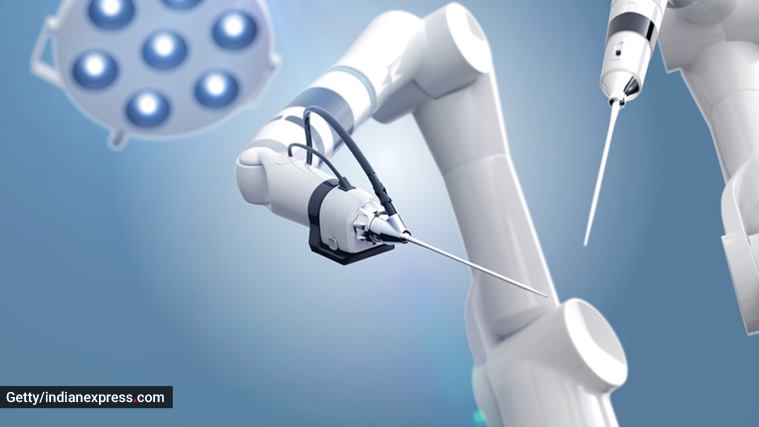Robotic joint replacement: All you need to know
From Siri, Alexa to self-driving cars and autopilot planes to satellite mapping, the world has seen the benefial power of technology for the common man.
“The medical field, too, is not untouched; what we had seen as fiction in stories and movies, is now a reality. Artificial intelligence and robots are helping people do their jobs better. In the field of orthopaedic surgery, robotics-assisted knee replacement is revolutionising the way knee replacements are done. These advanced robots have made their way into the operating room floor, assisting surgeons in attaining precision and accuracy during surgery. Today, robotics has become a new tool in hospitals to provide the best treatment,” Dr Shubhang Aggarwal, senior joint replacement surgeon, NHS Hospital, Jalandhar tells indianexpress.com.
What is a robotic joint replacement?
Imagine a pilot flying a plane through a thick fog. A few years ago, they would use only their senses and imagination to land the plane safely. But with the advancement in technology, the same pilot now has high-quality satellite guidance; the autopilot mode allows the sensors and an algorithm guide the plane to land smoothly. Similarly, things have changed from when an orthopaedic surgeon did a conventional surgery where he relied on eyeballing with his 2D vision for assessment of deformity and making the bone cuts. Now, he can use high-end robotics, with self learning artificial intelligence to create a live 4D map of the joint, seeing the ideal placement of the artificial implant to be put and then the robotic tool burring off just that much little bone, needed to get the perfect fit of implant, saving the natural bone and ligaments.
The technology has moved on from the previous implant positioning techniques that used long rods drilled into the central canal of the femur (thigh bone) to provide an attachment point for surgical cutting guides to jigless robotic planning and execution.
The most advanced innovation is the Navio Surgical System, a robotic platform that does not need any CT scan or MRIs and creates a real time image of the limb and deformity and the surgeon is able to visualise all around the knee and make a plan on how it is going to be after surgery even before the bone is touched.
This robotic system clearly demonstrates the excellence in the field of knee replacement surgery. Using the Navio system, a surgeon is able to understand the unique anatomy of each individual knee, gets the knee in natural alignment of the hip and ankle and the perfect sizing ensures that the tracking of the knee is balanced in the artificial implant throughout the range of movement. The surgeon can now place the implant with sub-millimetric precision which works and feels just like your God given natural knees. Such robot-assisted Knee replacement surgery involves negligible blood loss, much less pain, little tissue invasion and accurate positioning the implant with long-lasting results.
After such a procedure, a patient can start walking only 3 hours after the surgery and go back to home within 3 days as of now and with better anesthesia and rehab modalities, we are targeting one day discharge! So going with a robotic knee replacement surgery, the hospital stay period of a patient is reduced. It makes sense in Covid, decreasing the exposure to a minimal level.
 The introduction of robotics has improved the way doctors do surgery, including joint replacements. (Photo: Getty/Thinkstock)
The introduction of robotics has improved the way doctors do surgery, including joint replacements. (Photo: Getty/Thinkstock)
What are the advantages of a robotic joint replacement?
The primary reason for the development of the robotic systems was the endeavor to improve outcomes for patients. Although, with research, we have better metal and ceramics in hip and knee replacement prosthesis, but placement of these implants the right way makes all the difference. It has been observed that with the use of traditional methods of surgery, there are some number of patients who are dissatisfied with the outcome. With the use of artificial intelligence-enabled robotic technology and aim and hope that these procedures will get accuracy in implant positioning, and with natural soft tissue balance, tracking improves and that will consequently improve further the satisfaction levels from surgery.
The Navio system offers two important benefits: first, it helps the surgeon to create a highly individualised plan specific to the patient and he is not exposed to any potentially harmful radiation, as opposed to the earlier methods of CT scans. The second benefit is robotic assistance that combines advanced technology to gives a perfect accurate placement of artificial knee and aim at better long-term outcomes, for long-lasting 30-40 years at much cheaper cost.
Over the past couple of years, studies have focused on the pinpoint accuracy of the robotic-assisted knee replacement system. A study by orthopedic surgeon Geoffrey Westrich and colleagues published in the Journal of Knee Surgery found that the robotic system allows increased accuracy and precision and is beneficial in the training of orthopedic surgeons. In another study by researchers in the United Kingdom, published in the Bone & Joint Journal in 2018, it was found that robotic-assisted total knee replacement was linked with a shorter hospital stay, decreased pain after surgery and improved early functional recovery.
Along with the precision, the robotic‐assisted procedures also offer more protection to the surrounding soft tissues at the surgical site and facilitate more healthy bone to be preserved. During the surgery, the implant or components that replace your old joints are typically made from metal, ceramic, or plastic. Robotic assistance allows your surgeon to place your implant more efficiently. And robotic surgery leaves much smaller and less invasive scars as compared to traditional surgery.
Paving the way for the future
The introduction of robotics has improved the way doctors do surgery, including joint replacements. As the technology grows more and more people demand this kind of accuracy that robotics can provide for their hip and knee replacement surgeries. These AI-led robots allow the surgeon to combine his judgment and knowledge with the control and precision of a robot, changing the way surgeries would be done in the future.
For all the latest health News Click Here

